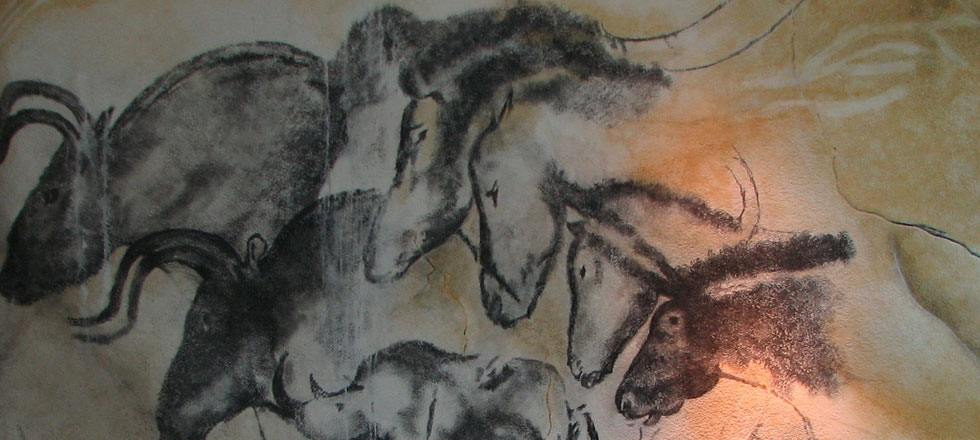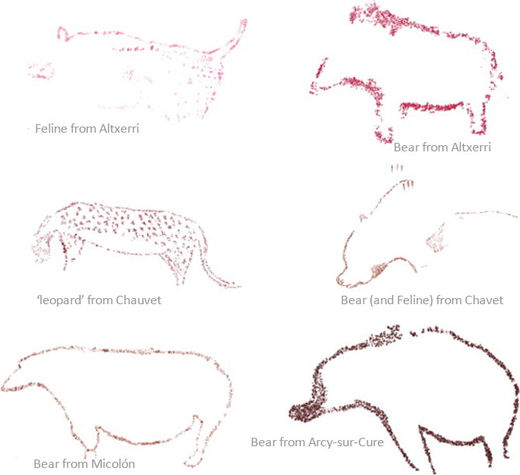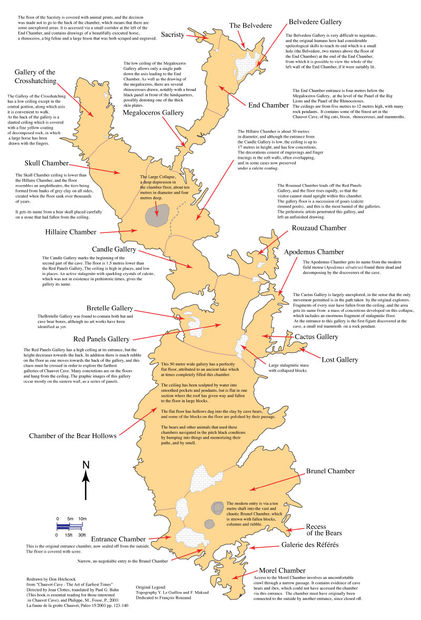The cave, extends horizontally for nearly 500 metres and is located at the entrance to the Ardèche gorges between the Cevennes and Rhone valleys. Over 425 groups of paintings have been documented and include numerous realistic renditions of animals (reindeer, horses, aurochs, rhinoceros, bison, lions, cave bears among others), human hand prints and abstract dots. The images in the front hall are primarily red, created with liberal applications of red ochre, while the back hall images are mainly black, drawn with charcoal.
The black drawings are grouped into two main phases; a paste of ground charcoal in water for the more recent and a dry charcoal stick for the earlier. However, the early age assigned to some of the black images have been called into question by researchers Jean Combiera and Guy Jouve, who have carried out a comparison with other cave art from the same period along with an examination of the original AMS radiocarbon dates.
No isolated moment of artistic genius
Combiera and Jouve argue that the site must be examined in its natural, cultural and thematic framework within a wider region, believing that the images do not represent an isolated moment of artistic genius from the Aurignacian period. By examining and comparing the red and black painted figures, as well as the engraved images, to the later Gravettian and Solutrean period examples, they feel there is a marked stylistic similarity, including the way that both mammoth and horse are portrayed.
They conclude that although Chauvet cave displays some unique characteristics, it appears to belong to a far more evolved phase of parietal art that sits within a Franco-Cantabrian tradition around 26,000 - 18,000 years ago. This tradition, the researchers argue, is far removed from the earlier motifs of its origins, known from art on stone blocks and shelter walls dated by stratigraphy to the Aurignacian (around 31,000 ± 1,000 BP) in France and Cantabrian region of Spain. The decoration from this period is often more stylistic and markedly geometric, and therefore the Chauvet animals would be too early for the Aurignacian period that they are presently dated to.
Growing evidence supports older date
However, there is another twist in the tale, and one which could weaken Combiera and Jouve's assertions. The site of Altxerri B in Spain has been found to contain similar and even older dated artworks stretching back 40,000 years. Archaeological, geological and stylistic evidence, together with radiometric dates, suggest an Aurignacian chronology for this Spanish cave art. The ensemble in Altxerri B can therefore be added to the small but growing number of sites dated to this period, corroborating the hypothesis of more complex and varied figurative art than had been supposed in the early Upper Palaeolithic.
Another piece of evidence that supports the earlier dating of the Chauvet images relies on the depiction of animals that would have been extinct by 29,000 years ago, such as the cave bear and rhinoceros, begging the question of how later groups painted animals that had been missing for thousands of years?
Origin of pigment not satisfactorily concluded
The other objection raised by Combiera and Jouve was to do with the results of the calibrated AMS radiocarbon, which they say may be incorrect. They argue that the origin of the black material used on the drawings was never satisfactorily identified, and this information - if for example it was coal or burnt shell - would have a major effect on the dating. However, it is also possible to counter argue that if this was the case, then the dates could actually be far older than those originally returned.
Jean Clottes and Jean-Michel Geneste are adamant that the original dates were obtained from material which was securely recovered. They claim in a book that is soon to be published, that a tight series of 14 dates between 30,140 BP and 31,870 BP correspond to the main phase of the creation of the black drawings which were directly dated. Four dates are a little more recent (<29,560 BP). All but one of the black drawings has been dated to the Aurignacian period.
Additional radiocarbon dating of the cave bear bones continues to support the original dates for the cave art, falling between 37,000 and 29,000 years old. Further, samples from a nearby cave support the idea that cave bears may have been extinct in the region by 29,000 years ago.
Robust challenges to the early dates have been attempted in the past, and ultimately failed. However, the potential for a stronger dating of the cave and the remarkable artistic activities that took place within are now being undertaken, and the debate is far from over.
Source: L'Anthropologie
Note: there is a website that allows you to explore the Chauvet Cave online and a replica and visitor centre is currently being constructed, which will open late 2014.
More information
- Jean Combiera, Guy Jouve 2014, New investigations into the cultural and stylistic identity of the Chauvet cave and its radiocarbon dating L'Anthropologie Vol 18 ( in French)
- González-Sainz C1, Ruiz-Redondo A, Garate-Maidagan D, Iriarte-Avilés E. (2013) Not only Chauvet: dating Aurignacian rock art in Altxerri B Cave (northern Spain). J Hum Evol. 2013 Oct;65(4):457-64. doi: 10.1016/j.jhevol.2013.08.001.
- Grotte Chauvet Archaeologically Dated, Communication at the International Rock Art Congress IRAC ´98 - Vila Real - Portugal (6-12 September 1998)
- Don's Maps. Chauvet (a comprehensive and fascinating look at the site and all things Palaeolithic)
- Moro Abad í a, O., and Gonz á lez Morales, M. - R., 2007 Thinking about "Style" in the "Post Stylistic Era": Reconstructing the Stylistic Context of Chauvet. Oxford Journal of Archaeology 26 ( 2 ): 109 - 127.
- B., McCormac, F.G., Manning, S.W., Reimer, R. - W., Richards, D.A., Southon, J.R., Talamo, S., Turney, C.S.M., van der Plicht, J., and Weyhenmeyer, C. - E., 2009 IntCal09 and Marine09 Radiocarbon Age Calibration Curves: 0 - 50,000 Years cal BP. Radiocarbon 51 ( 4 ): 1111 - 1150
- Vallada, H., Tisnerat - Laborde, N., Cachier, H., Arnold, M., Bernaldo de Quiros, F., Cabrera -Valdes, V., Clottes, J., Courtin, J., Fortea - Perez, J., Gonzales - Sainz, C., and Moure -Romanillo, A., 2001 Radiocarbon AMS Dates for Paleolithic Cave Paintings. Radiocarbon 43 ( 2B ): 977 - 986.







Reader Comments
to our Newsletter